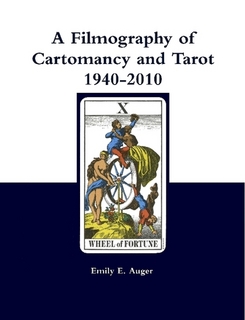This book is an amazingly detailed compilation of films featuring scenes where tarot or playing cards are used for divination. The international listing includes nearly 200 films. This book is a companion to Cartomancy and Tarot in Film 1940-2010 by the same author.
Films are arranged in alphabetical order. The entries begin with the film title, country of origin, and year of release. Beneath this header are production details including: writer (s), director, film genre; the deck used, the cards used, and cartomancy (who is using the cards in the film). There's a synopsis of the film's plot followed by a meticulous description of the scene or scenes that feature cards. Each entry ends with a “Discussion and Comparison” that describes how and why cards are used in the film, character motivations, and the titles of films with cards used in a similar way or by similar characters.
End matter includes “Decks Cited and Illustrations” and “Indexes” which cross-references films that aren't described in the book but are cited in the “Discussion and Comparison” notes. Many of these are from film sequels. The book is dedicated to films so the listings don't include card-reading scenes from television shows, documentaries, or other media appearances.
A Filmography of Cartomancy and Tarot 1940-2010 is impressive! A great deal of effort was expended in collating these films. Most listings occupy a single page. Auger gives longer descriptions of films that are particularly important to tarot lore or usage or historically important films, like “The Red Violin,” “The Ninth Gate,” and “A Touch of Evil.” Extra information includes notes from special features, commentaries, biographies, and from novels that were turned into films. The list includes a lot of horror films, which isn't particularly surprising; but what is surprising is how tarot scenes migrated into romantic comedies in the 1980s.
Tarot scenes generally function as a narrative component to help audiences follow the film's plot. Characters sometimes act out their readings through the remainder of a film; alternately, the character's path may run amok if the person ignores advice given in a reading. Auger includes descriptions of the set dressing featuring in tarot-reading scenes along with the outfit worn by the reader. Headscarves and gypsy bangles are all too common! Few films portray tarotists as people giving readings to earn some extra money without all the gypsy-diva trappings. The few that do stand out in the crowd (The Gift, USA, 2000). Movie tarot readings skew toward the ominous (predictions of disaster or death) or venal (the acquisition of love or money) with stultifying regularity.
This is a lengthy (nearly 400 pages) and big (8.5” x 11”) book. Entries are often illustrated with the actual cards from the decks used in the films. It's a fascinating study on how tarot and cartomancy have become a relatively common tool for fictional cinematic narratives. It also seems to underscore the stereotypes and misconceptions that bedevil working tarotists. It's an invaluable reference for tarotists that love movies. It should be required reading for screenplay writers! This is a book well worth acquiring for numerous reasons – a must-have reference work. Well done!
~review by Elizabeth Hazel
Author: Emily E. Auger
Valleyhome Books, 2016
398 pages.
POD through Lulubooks: $42.78 hard cover, $52.53 paperback
http://www.lulu.com/spotlight/ValleyhomeBooks
(check for coupon days for discounts)
A Filmography of Cartomancy and Tarot 1940-2010

©
2010 - 2025
Facing North
